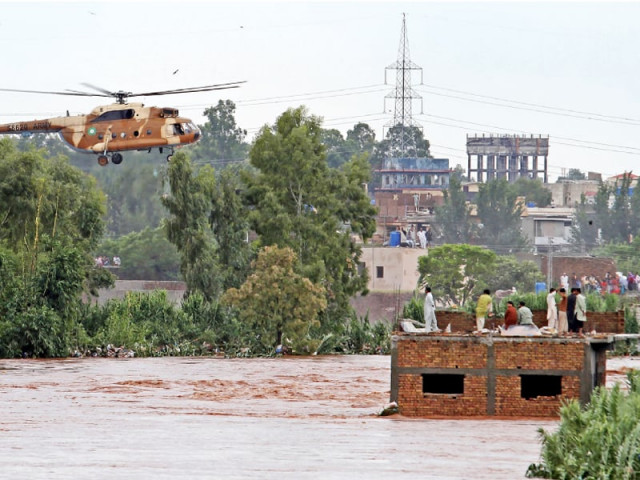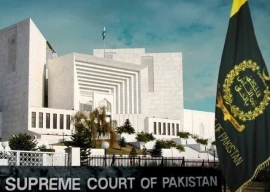
Heavy thunderstorms continued to pummel the upper parts of the country on Friday, leaving behind a wide trail of destruction across Punjab and Azad Kashmir and doubling the fatality count over the past 24 hours.
Officials confirmed the deaths of more than 100 people and said another 200 sustained injuries in rain-related incidents. Most of the fatalities were caused by roof collapses, mudslides and electrocutions, they said.
Flashfloods triggered by rain swept away dozens of homes and left at least 20 more people dead in the Azad Jammu and Kashmir (AJK) region.
According to police, 11 people were killed when their houses collapsed in different areas of Sudhanati district, some 190 kilometres from Muzaffarabad.

In Muzaffarabad, flashfloods damaged the Neelum Park and Tunnel Boring Machine (TBM) bridge of Neelum-Jehlum Hydel Power Project on River Jehlum near Majhoi. The raging waters also damaged the Cement Mixing Plant of Neelum-Jehlum power house in the same area.
Up to three rivers — Neelum, Jehlum and Poonch — are flowing above the danger mark and in view of the rising water levels, the State Disaster Mangement Authority (SDMA) has asked people living along the riverbank to relocate to safer areas.
Dozens of houses were damaged or swept away by the floodwater of River Neelum in the Central Plate area of Muzaffarabad. The flood waters swamped hotels and shops in Talimandi in the capital city.
The incessant rains have also damaged the roads in Hajeera, Bagh, Havayli and Sudhanati while the main road connecting Muzaffarabad with Islamabad remained closed at Kohala. The road leading up to the Neelum Valley was also blocked by large boulders and stones carried down by landslides along different areas.
Army soldiers carried out rescue operations in Hajeera and Rawalakot. They are working round the clock to clear the vital road of Hajeera and Rawalakot damaged by the torrential rains and landslides.
In Gilgit-Baltistan (G-B), the thunderstorms triggered landslides. In one instance at least eight people in Niyat Valley of Diamer district were swept away on Friday, taking the death toll to 11 across the G-B.
Another landslide struck Karis in Ghanche district, killing three car passengers and injuring two others. Two people were also wounded when the roof of a house collapsed in Kwardo, Skardu.
The landslides also swept away parts of Gilgit-Skardu road, suspending traffic between the two towns. Similarly, traffic between Gilgit and Rawalpindi was also suspended after the Karakoram Highway was damaged in Chilas and Kohistan.
Following a spell of rain, the water levels in Ghizer, Hunza, Astor and Skardu rivers have also risen to an alarming level, threatening the lives and properties of those living in the low-lying areas. In Hazara district of Khyber Pakhtunkwa (K-P) around six villagers were killed and another injured when the roofs of two houses collapsed in different parts.

DESIGN: Talha Khan
In Rawalpindi, heavy rain caused the deaths of nine people, while several others sustained injuries. Heavy downpours also inundated roads and low-lying areas.
People had to take refuge on the roofs of their houses in some areas including Christian Colony near Soan Bridge, Chontra and Adiala villages. Electric poles were also damaged and electricity remained suspended for almost six hours.
Military boats and helicopters rescued and evacuated 368 people from flooded areas to higher ground. According to the meteorological department, 279 mm of rain was recorded in Rawalpindi till filing of the report.
In Punjab’s provincial capital, Lahore, the death toll rose to around 20 following four more deaths on Friday. According to the statistics provided by the Provincial Monitoring Cell, these victims died in different incidents of roof collapses and electrocution while at least 71 were injured in Lahore within the last 48 hours. However; according to unofficial figures the death toll had soared to 23.
Seven people were reported dead in Faisalabad following incessant rain. More than three dozen people were also injured. Almost all the city drains were choked and overflowing as Water and Sanitation Agency (Wasa) failed to properly clean the drains before start of the rainy season.
Overall, 20 people have died in Lahore; seven in Faisalabad, nine in Rawalpindi, five in Sialkot, four each in Gujranwala and Jhelum, one in MB Din, two in Narowal, four in Kasur, one in Gujrat, two in Nankana Saheb and two in Hafizabad up till Friday evening.
NDMA hits out at Met office
The National Disaster Management Authority (NDMA) hit out at the Pakistan Meteorological Department on Friday for not providing timely warnings about the heavy thundershowers.
Speaking to The Express Tribune, Ahmed Kamal, an NDMA spokesperson, said the PMD gave them short notice to tackle the rain threat and thereby put them in a sticky situation.
He pointed out that the PMD’s previous forecast showed that normal levels of rainfall were expected in the month of September. But the downpours that began on September 3 have been anything but expected.
The NDMA spokesperson said it was too early to determine if it would be able to control the situation. “At this critical juncture, the NDMA does not have credible information on the nature and magnitude of the damage caused by the rain,” he said.
Mohammad Riaz, chief meteorologist at the Flood Forecasting Division of the PMD, refuted allegations that it had not informed the NDMA on time about the heavy thundershowers. “By blaming PMD, it is actually masking its own inefficiency,” Riaz said.
Published in The Express Tribune, September 6th, 2014.


















COMMENTS
Comments are moderated and generally will be posted if they are on-topic and not abusive.
For more information, please see our Comments FAQ